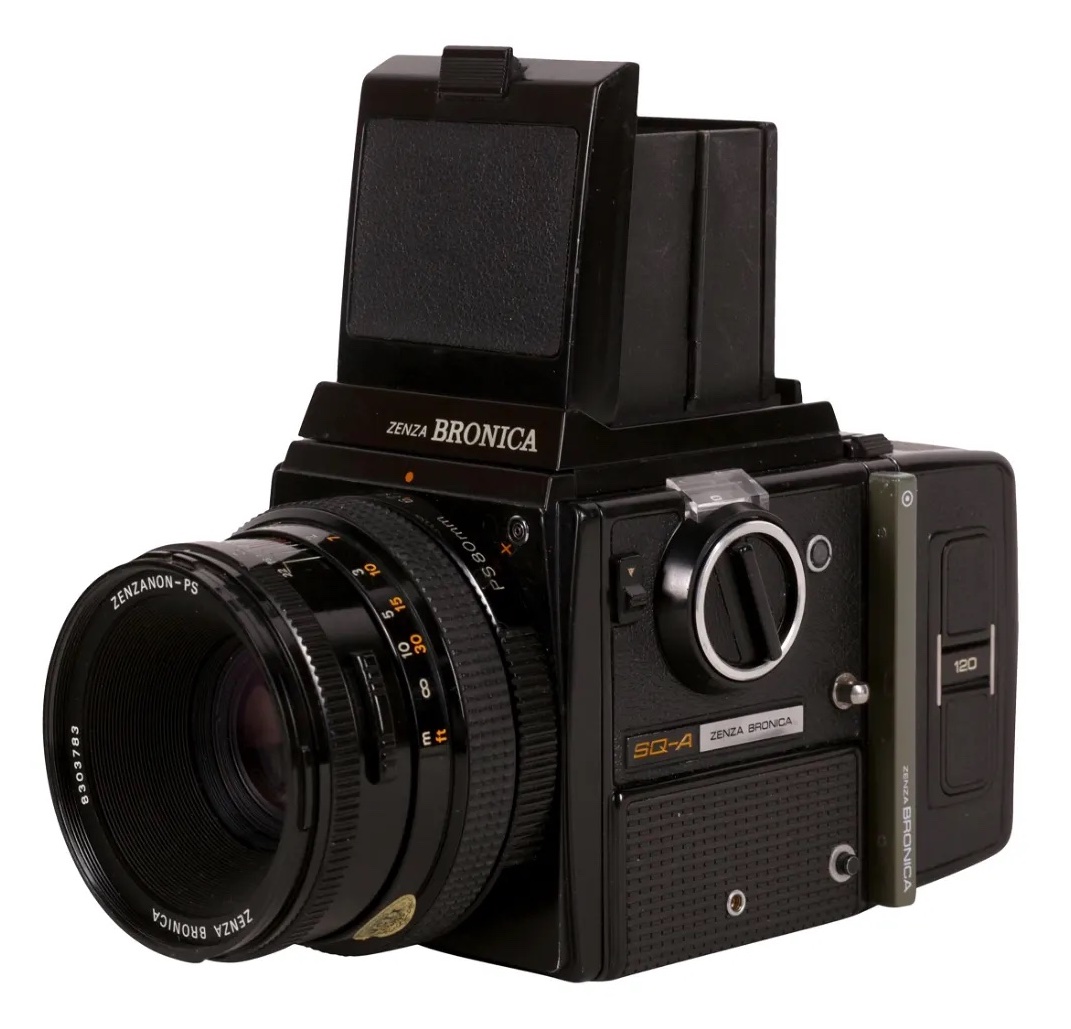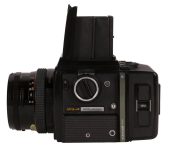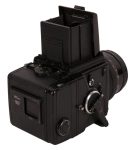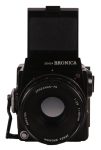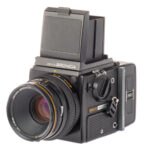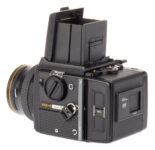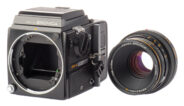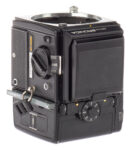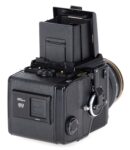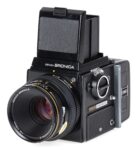Bronica SQ-A
Medium format MF film SLR camera
Specification
| Production details: | |
| Announced: | January 1982 |
| System: | ● Bronica SQ (1980) |
| Format: | |
| Maximum format: | Medium format 6x6 |
| Film type: | 120 roll film |
| 220 roll film | |
| Mount and Flange focal distance: | Bronica SQ [85mm] |
| Shutter: | |
| Type: | In-lens leaf shutter |
| Exposure: | |
| Exposure metering: | None |
| Exposure modes: | Manual |
| Physical characteristics: | |
| Weight: | 1500g |
| Dimensions: | 92x109x179mm |
Manufacturer description #1
Type: 6cm x 6cm format lens shutter single lens reflex camera, with interchangeable lens, film back, finder and focusing screen systems.
Frame size: 55.6mm x 55.6mm.
Film: 120 roll film (12 exposures) and 220 roll film (24 exposures), with exclusive film backs.
Lens mount: Exclusive four-claw Bronica SQ bayonet mount.
Focusing: Helical focusing system built into each lens.
Lens diaphragm: Fully automatic instant reopening lens diaphragm action; equal-distant aperture scale graduations; depth of field previewing.
Shutter: Electronic control SEIKO #0 between-lens leaf shutter; shutter speeds 8 sec. to 1/500 sec., without intermediate settings, plus T (time exposure); mechanical control 1/500 second.
Multiple exposure: Multiple exposure possible with lever on camera body.
Mirror lock-up: Mirror lock-up possible with switch lever on the side of camera body for a single or continuous picture taking.
Film back: Daylight loading interchangeable type; exclusive backs for 120 (12 exposures), 220 (24 exposures) roll films and Polaroid pack film; with ASA/ISO film speed dial on Film Back SQ 120/220 and ASA film speed switch on Polaroid Film Back S coupling to the finders with built-in exposure meter, when attached.
Finder: Interchangeable finder system.
Focusing screen: Interchangeable type. Standard type, supplied with camera, has split-image rangefinder spot surrounded by microprism ring and full-area matte screen. Optional types are (1) central matte spot, (2) full-area matte with grid-lines, (3) microprism spot and (4) split-image rangefinder spot.
Flash synchronization: X-setting (up to 1/500 sec.).
Battery checking: Red-colored LED lights up at front end of finder, outside screen area, when battery check button is depressed; also doubles as shutter closing signal.
Battery: Single 6-volt silver oxide battery (544, PX-28 or 4G13) or alkaline-manganese battery (A544 or 4LR44).
***
The Zenza Bronica SQ-A has been designed to take full advantage of the square 6cm x 6cm medium format and has been developed as a complete modular "system" camera, with a very high degree of interchangeability in lenses, finders, focusing screens, film backs, etc.
Manufacturer description #2
Bronica believes that a new concept is required in the relation between the photographer and camera, due to the diversification and individualism taking place in the portrayal of the photographic image. In other words, the photographer and camera must be able to work together, as a photographer-camera team, towards the same purpose, that of taking pictures meeting the highest requirements. The Bronica SQ-A and SQ-Am have been newly developed, with this concept in mind, and are single lens reflex camera system of the 6 x 6 cm format, based on the Bronica SQ, but incorporating great improvements in the system and camera themselves. The new Bronica SQ-A series is considered to be a complete fusion of the Bronica medivm format technology with modern camera electronics, with systematic coupling between camera body and accessories giving the photographer a very wide choice of operational controls, such as manual exposure control, as well as completely automatic exposure control. Furthermore, there are exclusive Bronica technologies throughout the system, such as electronic control lens shutter with electronic flash synching at all shutter speeds. Viewfinders, lenses and focusing screens can be interchanged to match specific requirements. A long Bronica tradition, film back interchangeability, is also available, as well as mirror lock-up. In fact, the SQ-A/SQ-Am simply abound with features designed for the professional user or features which have been incorporated so that the professional can use the SQ-A/SQ-Am for the ultimate goal of taking pictures meeting the highest standards of the photographic world.
Multi-Format System Camera - for All Types of Photographic Work
The Zenza Bronica SQ-A and SQ-Am have been developed for users who prefer working with the square 6x6 format. And, although the format size has not changed from the beginning, amazing changes have taken place in the photographic system to meet the different requirements of the professional and the amateur who simply wants to enjoy taking pictures.
The SQ-A Series is based on the traditional 6 x 6 format and has been developed as a full system of photography for fans of this format. And, while the basic photographic system does not change, it is only natural that different combinations of the system be used for taking different subjects, such as, for example, a portrait of a beautiful girl, a fast-breaking sports scene or a breath-taking phenomenon.
Interchangeable Finder System
Diaphragm-Priority AE with Thru-The-Lens Metering
The AE Prism Finder S converts the Bronica SQ-A / SQ-Am into a fully automatic camera, with through-lens metering and diaphragm-priority AE operations. A light pressure on the shutter button displays the shutter speed for the aperture selected and when fully stroked automatically controls the shutter speed, in stepless stages, for obtaining the proper exposure The electronic computer system takes over trouble some exposure calculations and frees the photographer for the most important task - that of taking the picture. And, Bronica has incorporated the AE system in the finder so that it can always be detached for using the body without automation. But, it's always possible to switch back to manual operations, with through-lens coupled metering,without even removing the finder, which lets the user move freely from one mode to the other. In other words, the AE Prism Finder S gives the Bronica SQ-A / SQ-Am action-following capability equaling the 35 mm single lens reflex.
Meter-Coupled Manual Operations
ME Prism Finder S and MF Finder S provide through-lens, match-LED, CdS metering, cross-coupling to both shutter speed and aperture, thus giving the photographer even greater freedom in exposure controls, with the shutter speed dial on the finder overriding the dial on the body. Exposure is adjusted while checking the greenIred LED symbols in the finder, which indicate correct exposure or show over- and under-exposure.
Interchangeable Film Back System
There is complete film back interchangeability - a traditional features of Bronica medium format cameras, ever since it was incorporated in the first Bronica camera in 1959. The film back is exchangeable freely, in daylight, by simply inserting dark slide, which makes it possible to choose that most suited for the work, from different film sizes and different formats. And, by using extra film backs, it's possible to intermix different color films or color and black-and-white, as required.
And, of course, this will reduce equipment on long assignments far from the studio. Based on technoIogical knowledge gained during long years of experience with the interchangeable film back system, maximum protection is provided against accidental force and shocks by incorporating double-locking safety features.
SQ-A Main Camera Body - the Center of the System
The main camera body is the center of the SQ-A system of photography, with finders, interchangeable lenses, film backs, grip, etc., added, as required, for producing the combination matching the assignment. One of the main features of the system camera is the breakdown into various parts, with many types available for each part. And, at the same time, the main body also incorporates a large, bright reflex mirror, the film winding mechanism, the shutter release mechanism and the shutter control circuit. (The SQ-Am also has a built-in motor drive system, too.)
Zenzanon Interchangeable Lenses
The Zenzanon-S lenses for the Bronica SQ-A Series have all been newly designed and are very compactly constructed, in spite of the lens shutter system, with grade-up in optical performance, too. Zenzanon lenses are widely recognized for sharp resolving power and natural color balance and available from super wide 40mm to telephoto 500mm, with a 2X tele-converter. And, automatic bellows attachment, close up lenses, filters, professional lens hood, etc. , are also available, and are very effective when used with the Zenzanon-S lenses.
Mirror Lock-Up System for Complete Prevention of Mirror Shocks
One of the chief attractions of the 6x6 format is the large negative size and the resulting overall image quality, which is traceable to their sharpness, resulting from sharpness of the interchangeable lenses, flatness of the film plane, stability in camera handling, etc. And, mirror lock-up also contributes towards sharper pictures. The mirror can be locked up, first, and the shutter released at the proper moment. This will prevent vibrations from the mirror action, with only a quiet lens shutter action taking place. Mirror lock-up will also prove valuable for slow shutter speeds in studio work, for close-up work, macrophotography and long telephoto work.
Simple Creative Expressions - with Multiple Exposures
Another merit of the medium format camera is the ease with which multiple exposures are possible, while taking full advantage of the large format. Furthermore, multiple exposures are very simple, in the case of the SQ-A Series, with a flip of multiple-exposure lever. This will make it possible to produce montages of a beautiful girl against a colorful sunset, or combine the sun and moon in one scene, or combine a slide-projected background with a portrature and thus produce illusions which do not exist. And, of course, the shutter can be cocked, without loading film, by utilizing the multiple-exposure lever, too.
From the editor
The weight and dimensions are indicated for the camera body with the Zenzanon-S 80mm F/2.8 lens mounted.
